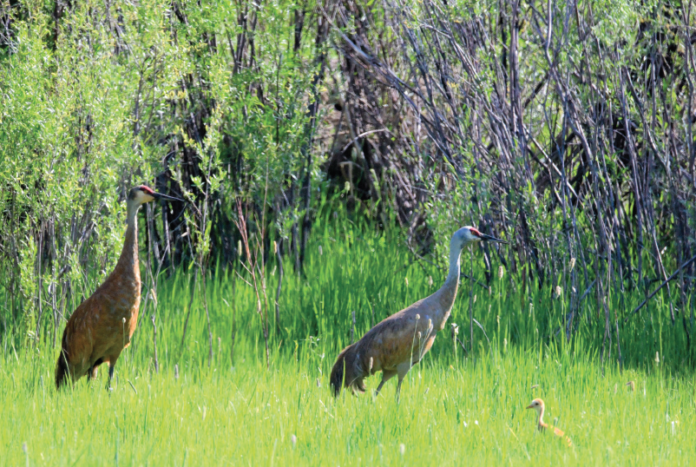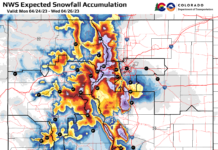by Marissa Lorenz
If one happened to be around and about Kremmling in the past week, an observant eye may have noticed a pair of Greater Sandhill Cranes happily grazing in a nearby meadow. And if one looked more closely, they would have seen one more family member, a fluffy chick tottering after its parents.
And while members of the species can often be seen passing through Grand County in the spring and fall, migrating to or from their staging areas in the Yampa and San Luis valleys, this is only the second local nest and chick that Colorado Parks and Wildlife (CPW) officers have verified in at least the 15 years.
“It is really rare,” says CPW Wildlife Biologist Michelle Cowardin, “–really special.”
Cranes are among the oldest species on the planet with fossil evidence dating back 10 million years. Of the 15 species of cranes in the world, only the Sandhill Crane can now be found in Colorado. And those that breed and stage in Northwest Colorado are specifically members of the Rocky Mountain Population of Greater Sandhill Cranes, according to the Colorado Crane Conservation Coalition (CCCC).
Although their numbers were once great, a 1961 study counted only 41 cranes in one Routt County staging area. In 1973, at the time Colorado’s Nongame, Endangered, or Threatened Species Act was passed, there were only 25 known breeding pairs in Northwest Colorado, and the species was added to the endangered species list.
Their numbers have increased with protection, and the subspecies was downlisted to threatened in 1993 and reclassified as a “Species of Special Concern” in 1998. Today, the CCCC’s website informs, it is estimated that there are between 250 and 300 nesting pairs among the Rocky Mountain Population of Greater Sandhill Cranes, including Kremmling’s happy couple.
However, if one were driving by on Monday morning, rather than the birds, one would have instead seen an employee of Vector Disease Control International (VDCI) walking around the privately-owned meadow and manually spraying insecticide throughout.
VDCI contracts with Kremmling for mosquito management also, working with area landowners, and the Town received calls from CPW and at least one citizen. As Town Manager Dan Stoltman is on vacation, Town Clerk Cassidy Bradley responded to the concern.
Bradley made several calls, finally reaching the VCDI field tech, Breanna Babcock, who immediately ceased the spraying, though she had already covered almost the entire area.
Babcock said that she had just been assigned to the site that morning, and with no one seemeding to know that it was being used as a nesting site. She noted that she was using a BTi (Bacillus thuringiensis) larvicide that, according to her job training, was nontoxic to anything larger than a gnat, and that she had not sprayed any adulticide.
However, VCDI had been aerial spraying the week before, at the request of the Town of Kremmling and other private landowners. That aerial spray is a permethrin-based spray, a chemical known to be “highly toxic” to fish and aquatic life, according to the National Pesticide Information Center.
Permethrin is generally considered to be non-toxic to birds, but. However, a recent study on its use to reduce parasites in wild birds’ nests noted that “treating nest material with permethrin significantly increased the number of hatchlings in the first generation and decreased fledgling success in the second generation. (…) For both generations, an interaction between permethrin treatment and age significantly affected nestling growth.”
VDCI has not responded to questions about the potential impact of the sprays to the birds or local aquatic life. Van Graham, Wildlife Scientist and retired Division of Wildlife Officer, who previously monitored crane nests in the upper Muddy Basin, on the east side of Rabbit Ears Pass, and in the southwest area of North Park, states that the application of pesticide on the area could definitely have an impact on the birds’ food supply.
“Chicks eat a lot of insects,” he explains. “They feed on some small vegetation but, especially in the early stages, protein is really important for growing chicks.”
CPW’s Cowardin also indicated that disturbing a bird’s nesting site could result in the parents abandoning the site or in the chick being separated from the parents in its fright.
Fortunately, the parents and chick were seen together again on Tuesday. Cowardin reports, “The Town is fully supportive of protecting the chick and the cranes.”
Indeed, Bradley indicated that “all entities are equally concerned about the health, safety, and preservation of the birds.
However, due to their location, the town may only suggest and advise for precautions to be taken, while any decisions to continue or discontinue with mosquito mitigation in the particular area will lie with the property owner.
Any forced discontinuance of the mosquito application in the immediate vicinity of the nest would come from the State of Colorado.”
If the birds remain healthy and follow the pattern of nesting cranes in the Yampa Valley, they could be expected to remain in the area through the end of September when they will migrate south to the San Luis Valley and on to wintering grounds in New Mexico, Arizona, and Northern Mexico.
And chances are good that they could return to Kremmling next March. Greater Sandhill Cranes generally mate for life, and both parents help with the incubation of eggs. They are known to return to the same nesting site year after year.
Young cranes are driven off when their parents begin nesting the following year. They form flocks of “bachelor” birds until they are ready to mate and begin breeding themselves around the age of four or five.
To learn more about Colorado’s Greater Sandhill Cranes, go to coloradocranes.org. Be sure to click on the Nest Camera, where you can see highlights of two Yampa Cranes, Athena and Rocky, nest and incubate some eggs, even fighting off raccoons to protect their young!
To learn more about BTi, permethrin, or other pesticides, go to the National Pesticide Information Center at http://npic.orst.edu/.
To read the full study on permethrin on birds’ nests, “Sub-lethal effects of permethrin exposure on a passerine: implications for managing ectoparasites in wild bird nests,” go to https://doi.org/10.1093/conphys/coaa076.









